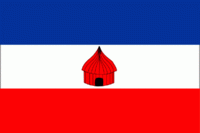Southern Nations (Southern Nations, Nationalities, and People's Region)
 |
The SNNPR borders Kenya to the south (including a small part of Lake Turkana), the Ilemi Triangle (a region claimed by Kenya and South Sudan) to the southwest, the South West Ethiopia Region to the west, the Oromia Region to the north and east, and the Sidama Region to the east. The region's major cities and towns include Arba Minch, Sodo, Jinka, Dila, Boditi, Areka, Butajira, Welkite, Bonga, Hosaena and Worabe.
The regional government of the Southern Nations, Nationalities, and Peoples' Region is based in the city of Hawassa. Following the formation of the Sidama Region in June 2020, Hawassa is located outside of the boundaries of the region. The regional government is planning to move to a city within the region's boundaries after two consecutive national electoral cycles. The largest cities in the region are Sodo with the population of 194,977 and Arba Minch with the population of 151,013
Based on the 2007 Census conducted by the Central Statistical Agency of Ethiopia (CSA), the SNNPR regional state had an estimated total population of 14,929,548, of whom 7,425,918 were men and 7,503,630 women. 13,433,991 or 89.98% of the population are estimated to be rural inhabitants, while 1,495,557 or 10.02% are urban; this makes the SNNPR Ethiopia's most rural region. With an estimated area of 105,887.18 square kilometers, this region has an estimated density of 141 people per square kilometer. For the entire region 3,110,995 households were counted, which results in an average for the region of 4.8 persons to a household, with urban households having on average 3.9 and rural households 4.9 people. The projected population for 2017 was 19,170,007.
In the previous census, conducted in 1994, the region's population was reported to be 10,377,028 of whom 5,161,787 were men and 5,215,241 were women. At the time of the census, the rural population of the Region accounted for 93.2% of the total population. Semien Omo, Wolayita, and Gurage were the three zones with the highest population. The population is concentrated mostly in eastern, northern and central part of the SNNPR while the western and southern part of the region is sparsely populated.
The SNNPR Water Resources Bureau announced that as of the fiscal year ending in 2006, they had increased the area of the region that had access to drinkable water to 54% from 10 to 15% 15 years ago. In August 2008, the head of public relations for the Bureau, Abdulkerim Nesru, announced that 94 million birr had been spent to further increase the availability of drinkable water in the region from 58% in the previous year to 63.6%. Priority was given to certain zones, such as Sidama, Welayta and Gurage, as well as the Alaba special woreda and several resettlement areas.
Values for other reported common indicators of the standard of living for the SNNPR include the following: 10.7% of the inhabitants fall into the lowest wealth quintile; adult literacy for men is 57% and for women 22.4%; and the Regional infant mortality rate is 85 infant deaths per 1,000 live births, which is greater than the nationwide average of 77; at least half of these deaths occurred in the infants’ first month of life.
Map - Southern Nations (Southern Nations, Nationalities, and People's Region)
Map
Country - Ethiopia
 |
 |
| Flag of Ethiopia | |
Anatomically modern humans emerged from modern-day Ethiopia and set out to the Near East and elsewhere in the Middle Paleolithic period. Southwestern Ethiopia has been proposed as a possible homeland of the Afroasiatic language family. In 980 BCE, the Kingdom of D'mt extended its realm over Eritrea and the northern region of Ethiopia, while the Kingdom of Aksum maintained a unified civilization in the region for 900 years. Christianity was embraced by the kingdom in 330, and Islam arrived by the first Hijra in 615. After the collapse of Aksum in 960, a variety of kingdoms, largely tribal confederations, existed in the land of Ethiopia. The Zagwe dynasty ruled the north-central parts until being overthrown by Yekuno Amlak in 1270, inaugurating the Ethiopian Empire and the Solomonic dynasty, claimed descent from the biblical Solomon and Queen of Sheba under their son Menelik I. By the 14th century, the empire grew in prestige through territorial expansion and fighting against adjacent territories; most notably, the Ethiopian–Adal War (1529–1543) contributed to fragmentation of the empire, which ultimately fell under a decentralization known as Zemene Mesafint in the mid-18th century. Emperor Tewodros II ended Zemene Mesafint at the beginning of his reign in 1855, marking the reunification and modernization of Ethiopia.
Currency / Language
| ISO | Currency | Symbol | Significant figures |
|---|---|---|---|
| ETB | Ethiopian birr | Br | 2 |
| ISO | Language |
|---|---|
| AM | Amharic language |
| EN | English language |
| OM | Oromo language |
| SO | Somali language |
| TI | Tigrinya language |















